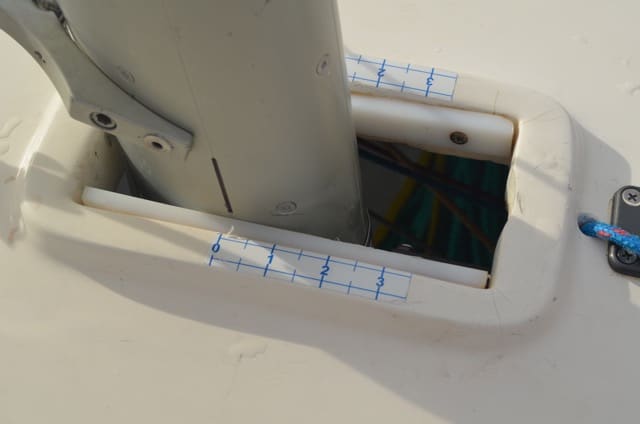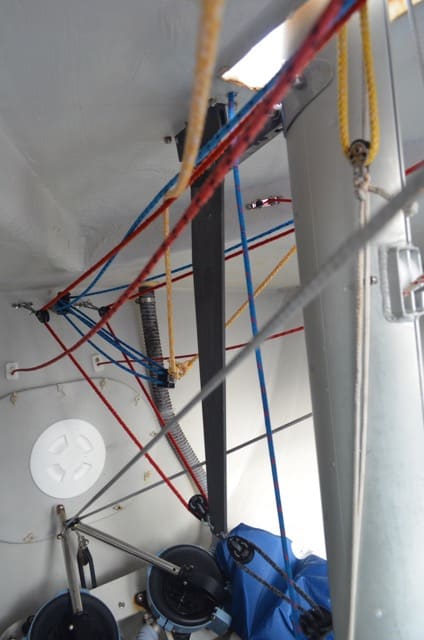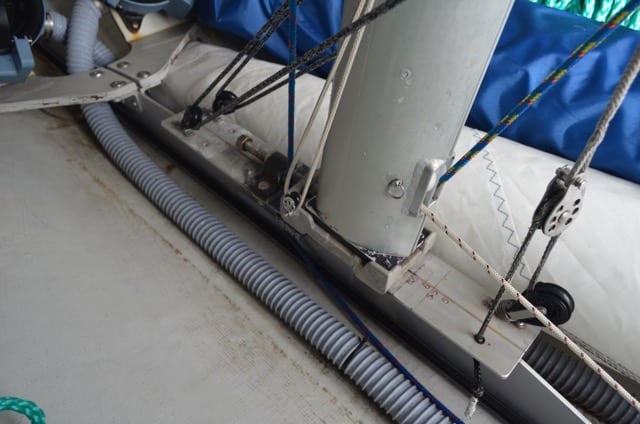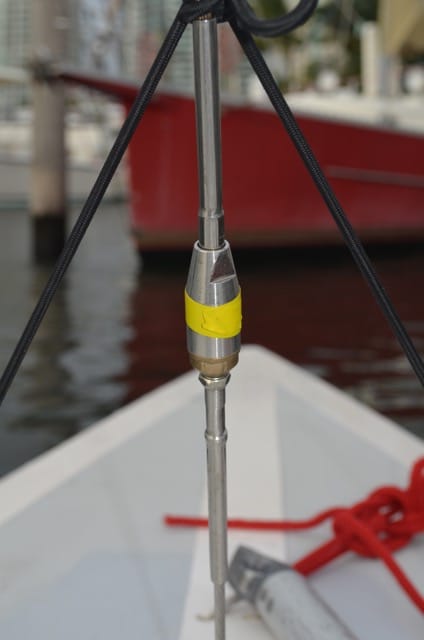In the build-up to the 2015 Etchells Worlds in Hong Kong, my team on Aretas changed two key important items designed by Andrew Palfrey, an Etchells world champ and Olympic sailor, and recently adopted by the class.
The first is a forestay adjuster. The old system involved taking the forestay pin out (that’s right, no forestay attached), turning the pigtail to shorten or lengthen the forestay, and then reattaching the forestay. The new system never disconnects the forestay, making it safe, plus we could adjust it between races much more quickly.
The second item is a lever system that provides an alternative to the traditional mast step block and chocks used to control the mast position at deck level. The old block and chock system had limiting factors. One that frustrated me most was that the “steps” in the step block needed to be perfectly fit for your ideal mast position, but once we moved the mast butt, the chock didn’t fit as snugly. The “steps” only provided what I would call a gross-tune of the mast collar. Another problem is that mast movement was limited to the thicknesses of the chocks. Like other teams, we carried quarter-inch thick chocks, but there were times when we needed slightly less or slightly more. Plus, it was tough to get a tight enough fit to prevent the mast from pumping. Andrew’s under-deck lever got rid of all of that. Now, we could incrementally situate the mast in the partners in any position we needed. And we could do this on the fly. But it got even better.
Before each day of racing, we did what most everyone else does—sail upwind with our training partners. We had specific questions to answer. Was our forestay length right? Could we get enough mast bend if the wind increased? Could we get enough forestay sag if they wind decreased? My goal was always to create a range of adjustments that would allow us to depower or power up by making small, fine-tune changes.
Once we got the forestay, shrouds and mast butt in a comfortable spot for the conditions, I fine-tuned with the lever. If I needed to depower, I pulled on a lot of backstay, which tightened the forestay and made the jib flatter. Of course, that flattened the main. If I felt the main had become too flat, I used the lever to slide the mast aft, which deepened the main. Conversely, if I needed more power, I eased the backstay, which softened the forestay, powering up the jib. That also deepened the main, so I would lever the mast forward. That forced low bend in the mast and flattened the main. This “range” of adjustment was initially tough to correlate, but as we became more comfortable with the lever, we dialed everything in relatively quickly. As I adjusted the lever, I gauged the mast position by looking at the space between the aft edge of the mast and the back of the partners. To further quantify that, we put a vertical mark on each side of the mast with a sharpie and then a peel and stick numbers scale on the deck on either side of the mast. That way, Jeff Eiber, our forward crew, could confirm the mast location. Once into the race, rarely did we keep the mast in the same upwind position for the entire race. Whenever the wind built or dropped off, we moved the mast.
In addition to getting the sail plan set up for the entire range that we were expecting for the race, the lever also provided us with a nice tactical weapon. If we found ourselves in a tight lane, I used the lever to push the mast forward, pulled on a little more backstay and trimmed the main hard. That sacrificed some forward speed, but set us up in a point mode. When you have two-mile beats and living in a lane for a long time is critical, this is a nice tool to save your position. Done right, it allows you to sail up and off a leeward competitor and then, once clear, readjust for fast-forward speed, which is where our rig setup usually lives. If for some reason I’m not in the fast-forward mode and need to get there, such as if there being a shift ahead or maybe we need to cross a group of boats, I power up the rig. I let the mast back and ease the backstay. That makes both sails fuller and got us going fast.
Skip Dieball, along with crew Jon McClean and Jeff Eiber, won the 2015 Etchells World Championship, held in Hong Kong, this past November.













